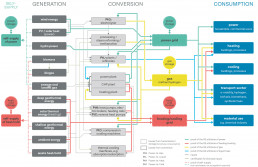Sectoral, legal and transnational interfaces in renewable energy verification systems
(Fundamentals Report G4)
The increasing use of renewable energy places high demands on the verification of their “renewable property”. In particular, in the case of converting energy from one form to another (especially to enable cross-sectoral use), preserving the undistorted renewable energy property is challenging. Comprehensive and transparent verification using different renewable energy verification systems requires dealing with several types of interfaces. These interfaces must be analysed in more detail to avoid any incompatibilities in their regulatory and technical design, to increase processing efficiency and to minimise frictional losses and transfer costs. As with the establishment of any verification system, the most important guiding criteria for interface management are to prevent the double marketing of the renewable energy property and to strengthen credibility vis-à-vis energy consumers.
This report covers the interfaces between both national renewable energy verification systems for one energy carrier and those of different energy carriers. These interconnection points are gaining importance not only due to the so far largely independent management of the different types of verification (e.g. guarantees of origin and mass balancing), but also due to energy conversion. The latter is becoming increasingly relevant, particularly in the context of sector coupling applications (especially power-to-X), which are to contribute to the flexibilization and decarbonisation of the energy system. In both cases, the reliable and secure traceability of the renewable energy property, possibly across several (secondary energy) conversion stages, is indispensable, both to meet regulatory requirements and to build trust with consumers.
Additional interfaces exist between verification and regulation, as certified renewable energy may be eligible to count towards regulatory requirements, both at the EU level and the national level. Finally, interfaces with the verification systems of other European states and, in the future, also non-European countries must be taken into account, as standardisation and harmonisation processes of the systems must be considered in order to enable the broad recognition of the certificates.
This topic is highly relevant for industrial companies that come into contact with the aforementioned interfaces between various national and international verification systems. Energy conversion is an integral part of many industrial processes, and verification of the renewable energy property may have to rely on several verification systems for different energy sources. Furthermore, when using hydrogen in industrial processes and importing it from non-EU countries, industrial companies are increasingly confronted with cross-EU verification. Finally, proper verification requires that industrial companies, be they consumers, processors or producers of energy, clearly define the purpose to be served by the renewable energy verification. In the industrial context, certificates may be required for disclosing the climate protection contribution of products (e.g. to customers), for emissions or CO2 accounting, to receive public subsidies or to fulfil regulatory obligations. Since different requirements may apply for each use case, the respective verification steps must also be considered when defining the purpose.
The Fundamentals Report G4 “Sectoral, legal and transnational interfaces in renewable energy verification systems” takes an in-depth look at these interfaces and highlights particular challenges associated with linking different verification systems both within a country and across countries.
Existing and future verification pathways for renewable energy



